How to Fix Electric Stove Temperature Control Issues
Updated: 31 May 2024
834
Are you tired of constantly burning your dishes on the stove? It’s time to take control of your cooking with electric stove temperature control. Cooking on an electric stove can be tricky, especially when it comes to getting the right temperature. This often leads to unevenly cooked meals and kitchen disasters.
Many home chefs struggle to achieve consistent results due to the unpredictable nature of electric stove temperatures. Whether it’s overcooked vegetables or charred meats, mastering temperature control is essential for culinary success.
In this post, we’ll discuss the importance of electric stove temperature control and provide practical tips for achieving perfect results every time. From understanding heat settings to adjusting to different cooking techniques, you’ll learn how to become the master of your kitchen. Let’s dive in and discover the keys to precision cooking on your electric stove!”
Understanding Electric Stove Temperature Control
In electric stoves, there are usually two main types of temperature control mechanisms:
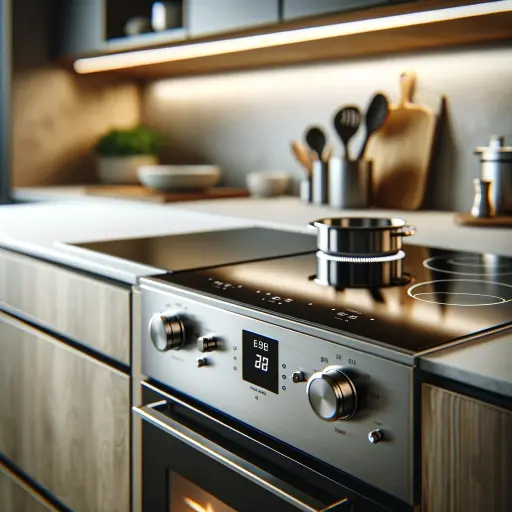
Types of Temperature Control Mechanism
Manual Temperature Control: This type of control usually involves turning a knob or pressing buttons to set the desired temperature. The knob or buttons are connected to a device called a thermostat inside the stove.
Automatic Temperature Control: This type of control is more advanced and often found in modern electric stoves. It uses sensors to detect the temperature inside the oven or on the cooking surface.
Different Types of Electric Stoves
Electric stove types do not have the same temperature control mechanism, all types have different temperature control systems. Detail is given below:

Coil Electric Stoves: These stoves have metal coils as heating elements on the cooking surface. Temperature control is usually manual.
Smooth top Electric Stoves: Smooth top stoves have a smooth glass-ceramic surface. They often come with touchpad controls for setting the temperature. Many smooth top stoves also feature automatic temperature.
Induction Electric Stoves: Induction stoves use electromagnetic induction to heat pots and pans directly. Temperature control is usually done through touchpad controls. They have automatic temperature control features.
Click here to explore more features of induction stoves.
Dual Fuel or Hybrid Stove: The temperature control mechanism for the gas cooktop in dual fuel stoves is usually manual. The temperature control mechanism for the electric oven in dual fuel stoves can vary. Some models offer manual control, while others may feature automatic temperature control.
Smart Stove: Smart stoves often feature precise temperature control capabilities through their connected apps. Users can set specific temperatures with precision, ensuring accurate cooking results.
Identifying Common Temperature Control Issues
Here is a complete guide to troubleshooting and identifying temperature control issues:

- Check the Settings: Make sure the temperature settings are correctly adjusted. If you have a manual control knob, ensure it’s set to the desired temperature. For smart stoves, verify that the settings are accurate on the app or control panel.
- Test the Thermostat: If the stove has a thermostat, it could be faulty. To test it, set the stove to a specific temperature and use an oven thermometer to see if it matches the displayed temperature.
- Inspect the Heating Elements: Broken or malfunctioning heating elements can cause temperature issues. Visually inspect them for any signs of damage or wear.
- Clean the Stove: The build-up of food debris or grease can affect temperature control. Clean the stove thoroughly.
- Check for Electrical Issues: Ensure the stove is properly plugged in and receiving power. If there are any electrical issues, consult a qualified electrician.
5 Electric Stove Temperature Control Problems
Electric Stove Temperature Fluctuations
Here are some factors that may cause temperature fluctuations:
- Uneven or damaged heating elements
- Inadequate insulation
- External factors such as drafts or opening the oven door

Solutions:
- Inspect the heating elements for any signs of damage. Replace any faulty elements to ensure even heat distribution.
- Check the oven door seal for any gaps or damage. Replace the seal to improve insulation.
- Minimize drafts by ensuring windows and doors are closed when using the stove.
Electric Stove Low Temperature Problem
When your electric stove doesn’t heat sufficiently, it could be due to various reasons:
- Dirty or faulty heating elements.
- Malfunctioning thermostat.
- Insufficient power supply.
Solutions:
- Start by cleaning the heating elements and removing any built-up residue or debris.
- Check the thermostat to ensure it’s functioning properly. If necessary, replace it.
- Verify that the stove is receiving adequate power. Check the circuit breaker to ensure there are no issues with the electrical supply.
- If the problem persists, consider consulting a professional technician.
Why Electric Stove Temperature Won’t Maintain?
The following are the main factors preventing temperature maintenance:
- Faulty Thermostat
- Poor Insulation
- Dirty or Damaged Heating Elements
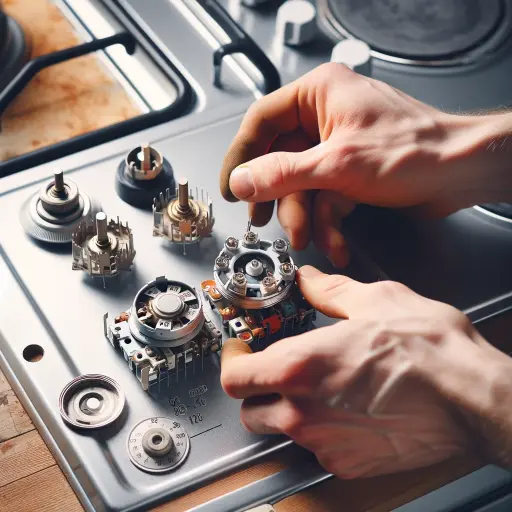
Solutions:
- Check and recalibrate the thermostat to ensure it’s accurately controlling the temperature.
- Inspect the oven door seal for any damage. Replace the seal to improve insulation.
- Clean the heating elements to remove any debris. Replace damaged elements as required.
- Minimize drafts by keeping windows and doors closed when using the stove.
Electric Stove Temperature Control Knob Issues
Electric stove knobs may have the following problems:
- Loose or wobbly knobs
- Knobs difficult to turn or adjust
- Knobs not accurately reflecting the selected temperature
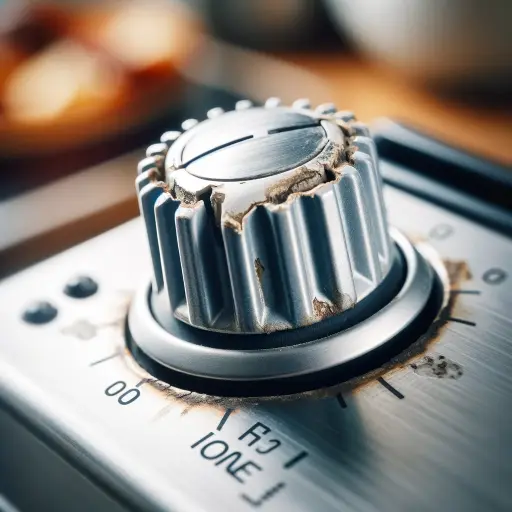
Solutions:
- Tighten any loose knobs using a screwdriver or wrench.
- Clean around the knobs to remove any debris that may be causing them to stick.
- If the knobs are difficult to turn, lubricate them with a silicone-based lubricant.
- If the knobs are not accurately reflecting the selected temperature, the control switch behind the knob may be faulty. In this case, replace the control switch.
Overheating Burners Issues
Here are some reasons why burners overheat:
- Accumulation of food residue or grease
- The burner may be set to a high temperature
- A defective control switch
Solutions:
- Clean the burners thoroughly using a wire brush to unclog the ports. Ensure the burner caps and grates are also clean.
- Adjust the temperature control knob to a lower setting. Monitor the burner to ensure it reaches the desired temperature without overheating.
- If the burner continues to overheat despite adjusting the control settings, the control switch may need to be replaced by a qualified technician.
How to Fix Electric Stove Temperature Issues
Simple DIY Fixes
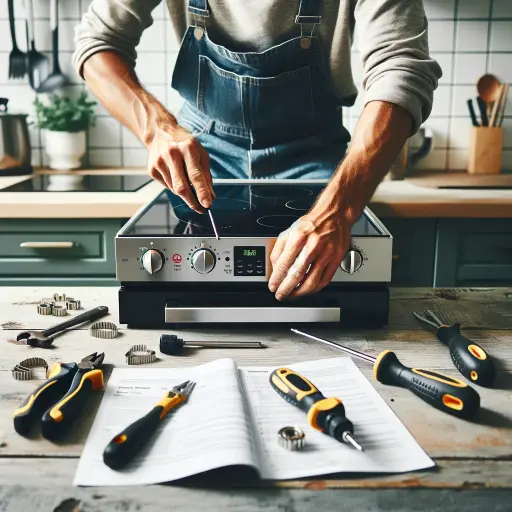
- Clean the Stove: Start by cleaning the stove thoroughly, including the burners, heating elements, and control knobs. Remove any food residue or debris that may be affecting temperature control.
- Check the Power Supply: Ensure the stove is properly plugged in and receiving power. If there are any issues with the power supply, such as a tripped circuit breaker or faulty outlet, address them before proceeding with repairs. Learn more about tripping circuit breakers: https://stovemastery.com/stove-keep-tripping-the-breaker-reasons/
- Inspect Control Knobs: Check the control knobs for any damage or wear. If the knobs are loose or difficult to turn, tighten them or replace them with new ones.
- Calibrate the Thermostat: If you suspect the thermostat is not accurately controlling the temperature, you can try calibrating it. Refer to the manufacturer’s instructions for specific calibration steps.
Inspect and Replace the Temperature Sensor
Locate the Temperature Sensor:
- Unplug the stove from the power source.
- Locate the temperature sensor inside the oven, usually near the back wall.
Test the Sensor:
- Use a multimeter to test the sensor’s resistance. Consult your stove’s manual for the correct resistance value at room temperature.
- If the resistance reading is incorrect, the sensor may be faulty.
Replace the Sensor:
- Unscrew and disconnect the faulty sensor.
- Install a new temperature sensor by connecting the wires and securing it with screws.
- Reassemble the stove and plug it back in.
Check and Adjust the Thermostat
Test the Thermostat:
- Access the thermostat by removing the stove’s control panel.
- Use a multimeter to test for continuity. A faulty thermostat will show no continuity.
Adjust or Replace the Thermostat:
- If the thermostat is adjustable, use a screwdriver to adjust the calibration according to the manufacturer’s instructions.
- If the thermostat is faulty, replace it with a new one by disconnecting the wires and securing the new thermostat in place.
Inspect and Replace Heating Elements
Test the Heating Elements:
- Unplug the stove and remove the heating elements.
- Use a multimeter to test for continuity. A broken element will show no continuity.
Replace Faulty Heating Elements:
- Disconnect the faulty element and replace it with a new one.
- Secure the new element and reassemble the stove.
Clean or Replace Control Knobs
Clean the Knobs:
- Remove the control knobs from the stove.
- Clean the knobs and the control shaft with a mild cleaner to remove dirt and grime.
Replace Worn-Out Knobs:
- If the knobs are worn out and do not engage properly, replace them with new ones.
- Ensure the new knobs fit securely and turn smoothly.
Check and Tighten Electrical Connections
Inspect the Connections:
- Unplug the stove and remove the back panel to access the wiring.
- Inspect all electrical connections for signs of looseness or corrosion.
Tighten or Replace Connections:
- Tighten any loose connections using a screwdriver.
- Replace any corroded or damaged wires.
Test and Replace the Control Board
Test the Control Board:
- Access the control board by removing the stove’s control panel.
- Inspect the board for visible signs of damage, such as burnt components.
Replace the Control Board:
- If the control board is damaged, disconnect it from the wiring check or harness.
- Install a new control board and reconnect the wiring harness.
- Reassemble the stove and test its functionality.
Verify the Power Supply
Check the Voltage:
- Use a multimeter to check the voltage at the stove’s power outlet. Ensure it matches the stove’s requirements.
- If the voltage is incorrect, consult an electrician to address the issue.
Advanced Techniques and Tools
Here are some additional tools for better temperature control:
Heat Diffusers: A heat diffuser is a flat metal plate that you place between your pot and the stove element. It helps spread the heat evenly and prevents hot spots. This is great for cooking sensitive dishes like rice or sauces that can easily burn.
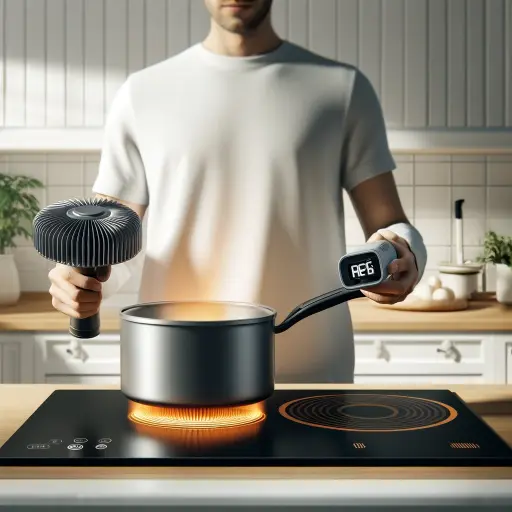
Laser Thermometers: Also known as infrared thermometers, these tools let you check the surface temperature of your pans without touching them. This is very useful for making sure your pan is perfectly preheated before you start cooking. This can easily prevent temperature control problems.
Conclusion
Mastering temperature control on your electric stove is essential for achieving the best cooking results. We encourage readers to troubleshoot and optimize electric stove temperature control issues and find simple fixes in our comprehensive guide. Additionally, a clean and well-maintained stove is important for precise temperature control, when you keep up with maintenance, you prevent many common temperature control problems.
Adopting these best practices will not only improve your cooking skills but also increase your satisfaction in the kitchen. With the right knowledge and tools, your electric stove can become a reliable partner for perfectly cooked meals.
FAQs
Why does my stove smell like it’s burning when adjusting the temperature?
- This could be due to food residue burning off or an electrical issue. Clean the stove and inspect for damage.
How can I maintain accurate temperature control on my stove?
- Regular maintenance, proper cleaning, and using the correct cookware can help maintain accurate temperature control.
References
- https://www.researchgate.net/publication/310953993_Temperature_Control_of_the_Electrically_Heated_Oven_Production_System_by_Using_Ziegler-Nichols_Method
- https://www.researchgate.net/publication/289609431_Research_on_the_temperature_control_system_of_electric_cooker
Please Write Your Comments